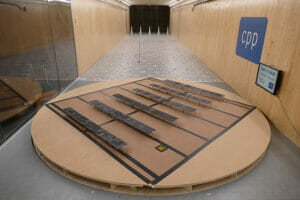Wind damage to solar tracking systems has appeared on various online forums and social media in recent years. These videos or pictures illustrate the catastrophic failures of multiple trackers over a site. The observed failures often happen in wind speeds well below the site design wind speeds.
In CPP Wind’s experience, most of these failures are due to the aeroelastic instability of the tracker system. This instability occurs when the wind loads change for the worse in response to the wind deflection of the system, creating a feedback loop. Once critical wind speeds are exceeded, tracker twisting will increase until a component or multiple components of the system fail. Most trackers are long and very flexible structures prone to this type of instability. However, this type of failure is avoidable with the right stow policy and design.
At CPP Wind, we focus on two main types of instability: Cyclical Torsional Divergence (CTD) and Vortex Lock In (VLI). CTD happens at low tilts (+/-10deg) and is related to the stiffness of the system. CPP has found that doubling or tripling the damping does not increase the critical wind speeds for CTD. This instability happens quickly and can often cause a failure in 2-3 cycles. Conversely, VLI dominates for moderate and high tilts and can be controlled by damping. Stiffness, span, and chord length also play a significant role in the critical wind speeds for VLI.
If your goal is to stow your tracker at a low tilt, one approach is to increase the stiffness of your system such that the instability speed is significantly higher than the ultimate strength design speed for the site. CPP can help by providing an optimization study for low tilt instability. This desktop analysis can help determine the best design to avoid instability failures.
If your preference is to stow at a moderate or high tilt, your system may need dampers or high inherent damping to avoid VLI instability. CPP can help evaluate the damping in your system through a pluck test review. For either preference, a state-of-the-art aeroelastic test ensures a robust, bankable, and cost-effective stow strategy for your system. Failures due to instability are avoidable with the proper testing, design, and stow policy.
Have you had a failure due to wind?

All aspects of the wind loading should be considered when performing a root-cause analysis of a wind-induced failure. These aspects include dynamic wind loads, instability, and variability of wind speeds across the site. CPP Wind can help determine the wind speeds at the site during the failure event, peer review the wind load calculations, and assess the risk of instability.
When you partner with CPP Wind, you will gain a comprehensive understanding of wind loads. And discover wind mitigation strategies that can save you money and reduce the risk of instability. For more information, view our Ground-Mount Solar informational flyer or contact us today to discuss the details of your solar tracking system.
We provide consulting in several languages, including English, Chinese, Spanish, French, and German.
